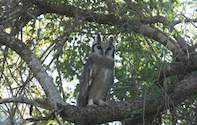
Preliminary results show that a total of nine Pel’s fishing owls (Scotopelia peli) were seen and counted during a recent survey of the Olifants River in the Kruger National Park, which compares poorly with a similar survey carried out in the 1990s.
The survey was carried out along the Olifants River from the western boundary fence of the Park, known as Mamba Picket, to the eastern boundary fence beyond Bangu Gorge, a distance of about 93 kilometres. The Olifants survey follows on from a similar survey carried out along the Luvhuvhu River in May 2007.
The team, comprising members of the Endangered Wildlife Trust (EWT), Kruger National Park (KNP) and volunteers from organisations such as the Honorary Rangers, the Moholoholo Rehabilitation Centre and private individuals identified a further 24 sites where positive signs of the birds' presence were identified.
"In addition, five potential nesting sites were located, although confirmation of active breeding at only one of these sites could be confirmed during the survey," says Andre Botha, manager of the Endangered Wildlife Trust's Birds of Prey Working Group (EWT-BoPWG).
Andre says, not taking into account the known pair of birds outside the Park, it is estimated that there are at most four to five breeding pairs along the Olifants in the Park at present. "This compares poorly with the findings of Begg in 1992 to 1994 when 18 birds were recorded and 15 areas for potential for these birds to breed were found."
Two teams, comprising six observers,undertook a ground survey over four days, with preference given to early morning observations. Three observers in each team covered the northern bank and three covered the southern bank, walking downstream. The observers recorded sightings of other waterbirds and raptors, noting only those flying in an easterly direction to prevent potential double counts.
Other Birds
The team counted 10 species of diurnal raptors and two other owl species during the survey. They counted 13 African fish eagle, (Haliaeetus vocifer), which reflects a 35 percent decline from the 21 birds recorded by Begg in 1992.
There were slightly more saddle-billed stork, (Ephippiorhynchus senegalensis), (seven) counted than in the previous survey, while the "white crowned lapwing, (Vanellus albiceps) seems to have a healthy population along the Olifants River with 67 birds recorded during the survey. This is however lower than the 104 birds counted in 1992."
According to Andre the low number of piscivorous bird species such as the great white egret, (Egretta alba), little egret, (Egretta garzetta), yellow-billed stork, (Mycteria ibis) and African spoonbill (Platelea alba) is worrying as these species were previously more common.
Prior to the ground survey, a scouting team conducted an aerial survey of the river course using Kruger's Bantam aircraft. "The aim was to identify areas of vegetation where Pel's fishing owl was likely to occur along the river and to compare these with sites where the birds have been recorded during the surveys in the 1990s."

The survey is part of a project undertaken by the EWT that aims "to do regular surveys of this species' range in South Africa to establish long-term population trends and implement appropriate strategies to address aspects that could threaten this species within its current range in South Africa," says Andre.
These trends could also be compared with those of bird species that share the same habitat and prey base.
This information can also be linked to the relevant "state of the rivers" update reports where appropriate.
According to Andre the EWT-BoPWG would like to achieve these aims by, amongst others, implementing an annual survey of this species' range within South Africa working with project partners such as Sanparks, Ezemvelo KZN Wildlife, land-owners and other NGO's.
More than half of southern Africa’s Pel’s fishing owl population is believed to occur within Kruger along Riverthe Limpopo-, Luvhuvhu-, Sabie- and Olifants rivers. “Additional pairs have also been recorded further west along the Limpopo-, Olifants- and Blyde rivers, outside Kruger as well as in Zululand.

